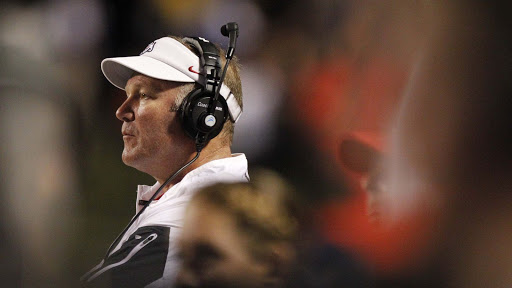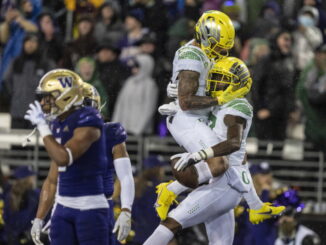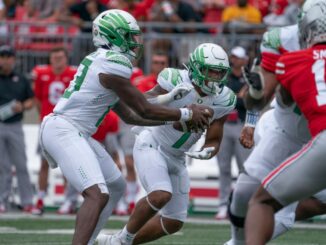
The Oregon Duck football program has added some established names to its defensive coaching staff.
Secondary coach Marcel Yates has more than 20 years as a college football coach, while new defensive coordinator Tim DeRuyter has more than 25 plus the bonus of being a head coach at the FBS level (Fresno State). Both were lured away from the California Golden Bears, and both were once together at Texas A&M.
Enough has been said about DeRuyter’s disruptive, high-pressure defense that I thought I would look into it and see just how disruptive it might be compared to what Oregon had under former defensive coordinator Andy Avalos.
The system I use (The Savvy Index) to predict college football games and trends uses various algorithms to assess each team’s pressure-ability. Still, for today’s pursuit, we’ll look at just sacks and tackles-for-loss.
There are several angles from which we can view things, and we’ll start with the question: How did California’s defensive pressure under DeRuyter for the past three years compare with Oregon in the same seasons?
Looking first at the number of sacks, we see that Oregon and California have been nearly identical over the past three seasons as each averaged 2.3 sacks per game. In terms of tackles-for-loss, I was surprised to discover that Oregon (6.4) has averaged more tackles-for-loss per game than Cal (5.6).
That result is even more surprising when we remember that Cal had Evan Weaver, the incredible, consensus All-American linebacker, who led the nation in 2019 for both tackles as well as solo tackles.
If we say that Oregon’s superior talent is a reason to annul that first analysis, then let’s take a look at Cal’s defensive pressure compared to that of its opponents in those years. When we do that, we find that Cal’s opponents posted even bigger differences. While Cal averaged 2.3 sacks per game, opponents averaged 3.7, and while the Golden Bears averaged 5.6 tackles for loss, their opponents averaged seven.
So far, we’ve compared Cal’s defense under DeRuyter against Oregon and Cal’s opponents and discovered that Cal was less effective in bringing pressure than either.
But once again, we also might say that a difference in talent would annul the second analysis. So, let’s compare Cal to itself. When I did that, I learned that DeRuyter’s pressure statistics in his three years at Cal were identical to the year before he took over.
None of the three comparisons shows that DeRuyter will bring an uncommon level of pressure to Oregon’s defense. It will be better this year than last, but there are some reasons for that other than DeRuyter, which we will see in a moment.
I’m not saying that DeRuyter’s defense won’t be better, but rather that analysts who are suggesting that Oregon will suddenly produce a hyper-pressure defense are probably setting the bar too high.
Before I get to some gems of hope in the new DeRuyter era, we need to be realistic about some points of concern from his last two gigs.
1) At Fresno State, DeRuyter inherited academic All-American quarterback Derek Carr. At Cal, he inherited All American linebacker, Evan Weaver. Both of them thrived under his leadership, but once they were gone, Fresno State went from a record of 20-6 with Carr to 10-24 without him, and Cal’s defense went from 21.2 ppg with Weaver to 26.5 without him.
2) At Fresno State and California, DeRuyter never recruited a defensive player with a 247sports rating higher than three stars.
There is little question that Tim DeRuyter knows how to make the most of defensive talent. When Weaver entered the Cal program in 2016, he spent two years in relative anonymity. When DeRuyter arrived in 2018, Weaver became the most dominant defensive player in the West. After graduation, he was drafted into the NFL by the Arizona Cardinals but was cut the following September. Weaver flourished with DeRuyter but floundered without him.
It’s clear that DeRuyter knows how to coach, and when he inherits talent, he produces results. With Oregon, he inherits the best talent he’s ever had so Duck fans can expect a much better defense. Will it bring more pressure? I’m certain it will, but much of my certainty comes from Oregon’s performance last year when it ranked 91st in the nation for sacks and 95th in tackles-for-loss.
The bigger question is whether he can replace the magnificent talent at Oregon once it is gone and avert significant decline like he’s known in the past. Analysts agree that DeRuyter is not an elite recruiter. Still, the good news is that he is in a great place to change that because studies had shown that coordinators who spend two or more years in elite programs come away noticeably better than before they arrived.
Oregon has not reached elite status on the field, but under head coach Mario Cristobal, the program has become truly elite in recruiting. DeRuyter has a golden opportunity to “up” his recruiting game, and if he does, his reign at Oregon will be longer rather than shorter.
Duck fans can expect a greatly improved defense in 2021. After that, we’ll see if Tim DeRuyter is as good at receiving coaching as he is at giving it.




